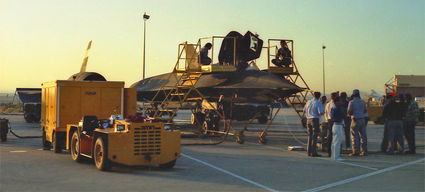My SR-71 experiences
May 23, 2020
I have always had a great interest in the Blackbird family of aircraft and have often visited Blackbird Air Park in Palmdale. On display there you can see a YF-12, an SR-71 side-by-side and a D-21 drone which was tested on the back of a Blackbird, launched in-flight in the early 1960s.
The Lockheed SR-71 “Blackbird” is a long-range, high-altitude, Mach 3 strategic reconnaissance aircraft developed and manufactured by Lockheed Corporation. It was originally used as a trainer, but in the 1960s NASA was doing research flying. The Blackbird SR-71 model is very distinctive looking with a raised rear cockpit so the instructor can have a better front looking view.
During the 1990s two SR-71 Blackbird aircraft were used by NASA as testbeds for high-speed, high-altitude research at the then Dryden Flight Research Center which was renamed in 2014 the NASA Neil A. Armstrong Flight Research Center (AFRC) located at Edwards Air Force Base in California.
The SR-71 was the most advanced member of the Blackbird family joining the A-12, designed by Clarence “Kelly” Johnson, the precursor of the YF-12 built at Lockheed’s “Skunk Works,” now located in Palmdale. President Johnson announced the YF-12A Interceptor on Feb. 29, 1964. The SR-71 made its first flight on Dec. 22, 1964. These were very secret classified projects until 1976. Blackbirds remain the world’s fastest and highest flying production aircraft ever built.
Back in 1992, I was an on-call contract photographer for NASA and got to be around some of the most interesting and fantastic research aircraft. Back then, NASA was flying F-18 Hornets, F-104 Starfighters and T-38 Talons, to mention a few.
One day I received an assignment to do video photography of the start up and take off of a Blackbird Model SR-71 (61-7956/NASA #831). The plane taxied out to the “Hot Gun Line” for inspection before takeoff. I remember it was a long process of injecting air and using four motor V-8 starting carts to start the aircraft.
I was able to talk with the crew and I was asked to ride in the crew truck out to the Hot Gun Line. It was an amazing experience to be seated, watching the world’s fastest aircraft (that takes off from a runway) taxiing alongside the crew truck. The aircraft leaks the JP 8 fuel on the ground as it moves out to the runway which is normal with inflight Mach 3 speeds heating the fuel tanks seal. The SR-71 does not take off with a full load of fuel. The first thing the crew does is “hit the tanker” to top off fuel for the mission which is better known as inflight refueling with a KC-10 tanker. Inflight at Mach 3 the SR-71 gains length due to the speeds and heat created by the atmosphere at 80,000 feet.
After the inspection at the Hot Gun Line, I went out to shoot video of the take-off. I was about 60 to 80 feet from the wing tip. I was asked to be there by the crew. My gut told me I was too close but a crew member was near me watching my back. I was wearing ear plugs and headphone ear protection. I was very thankful I did but was not fully prepared for what I was going to see.
To this day I never have heard anything as loud as this monster aircraft. Wow! Those two J58 engines were loud. The SR-71 used two Pratt & Whitney J58 turbojets with afterburner producing 32,500 pounds of thrust, less than 20 percent of total thrust is used to fly at Mach 3. Mach 3.2 is the max speed specification for the SR-71. The design uses a movable conical spike in front of the engine nacelle to control/balance the thrust during high-speed cruise acting as Ramjet at Mach 3. This was a surreal moment, almost a religious experience, that I will never forget. The takeoff made me think of all the incredibly smart people that designed, built, worked on and flew this fantastic aircraft.
Looking back on my aviation photography and experiencing this day with people involved, made a great impression on me. I was right; I was a bit too close. The SR-71 was so loud that it created break-up and distortion in the video signal recording the footage I shot. When we looked at it, it was still usable for the crew’s needs.
Where this aircraft was designed, in Burbank, Calif. in the 1950s, steam engines were running on the rails that were capable of top speeds around 100 mph. If people of that day were to see the SR 71 in flight they would possibly think it was from out of this world, with it capable of speeds of 2,220 mph and more.
NASA SR71B (61-7956/NASA #831) was on loan from the US Air Force. It arrived at Dryden on July 25, 1991 and served as a research platform, as well for crew training and proficiency until October 1997.
NASA SR-71 B #831 is currently on display at Air Zoo in Portage, Michigan.





